Experimental Study: Serial Position Effect in Recalling Ordered Words
VerifiedAdded on 2023/05/30
|14
|2851
|143
Report
AI Summary
This report investigates the serial position effect in recalling ordered words among Kaplan students. The study examines the theories of primacy and recency using data collected from 11 participants who were asked to recall words from four different lists. Two data examination techniques wer...

Running head: SERIAL POSITION EFFECT IN RECALLING ORDERED WORDS
1
Serial Position Effect in Recalling Ordered Words Paper
Student's Name
Professor's Name
Affiliation
Date
1
Serial Position Effect in Recalling Ordered Words Paper
Student's Name
Professor's Name
Affiliation
Date
Paraphrase This Document
Need a fresh take? Get an instant paraphrase of this document with our AI Paraphraser

SERIAL POSITION EFFECT IN RECALLING ORDERED WORDS
2
Table of Content
Serial Position Effect in Recalling Ordered Words.........................................................................3
Abstract........................................................................................................................................3
Introduction..................................................................................................................................3
Methods.......................................................................................................................................5
Results..........................................................................................................................................5
Data Collection........................................................................................................................5
Analysis results........................................................................................................................6
Discussion..................................................................................................................................10
Conclusion.................................................................................................................................11
Reference...................................................................................................................................12
Appendix....................................................................................................................................13
Serial Position Effect in Recalling Ordered Words
2
Table of Content
Serial Position Effect in Recalling Ordered Words.........................................................................3
Abstract........................................................................................................................................3
Introduction..................................................................................................................................3
Methods.......................................................................................................................................5
Results..........................................................................................................................................5
Data Collection........................................................................................................................5
Analysis results........................................................................................................................6
Discussion..................................................................................................................................10
Conclusion.................................................................................................................................11
Reference...................................................................................................................................12
Appendix....................................................................................................................................13
Serial Position Effect in Recalling Ordered Words
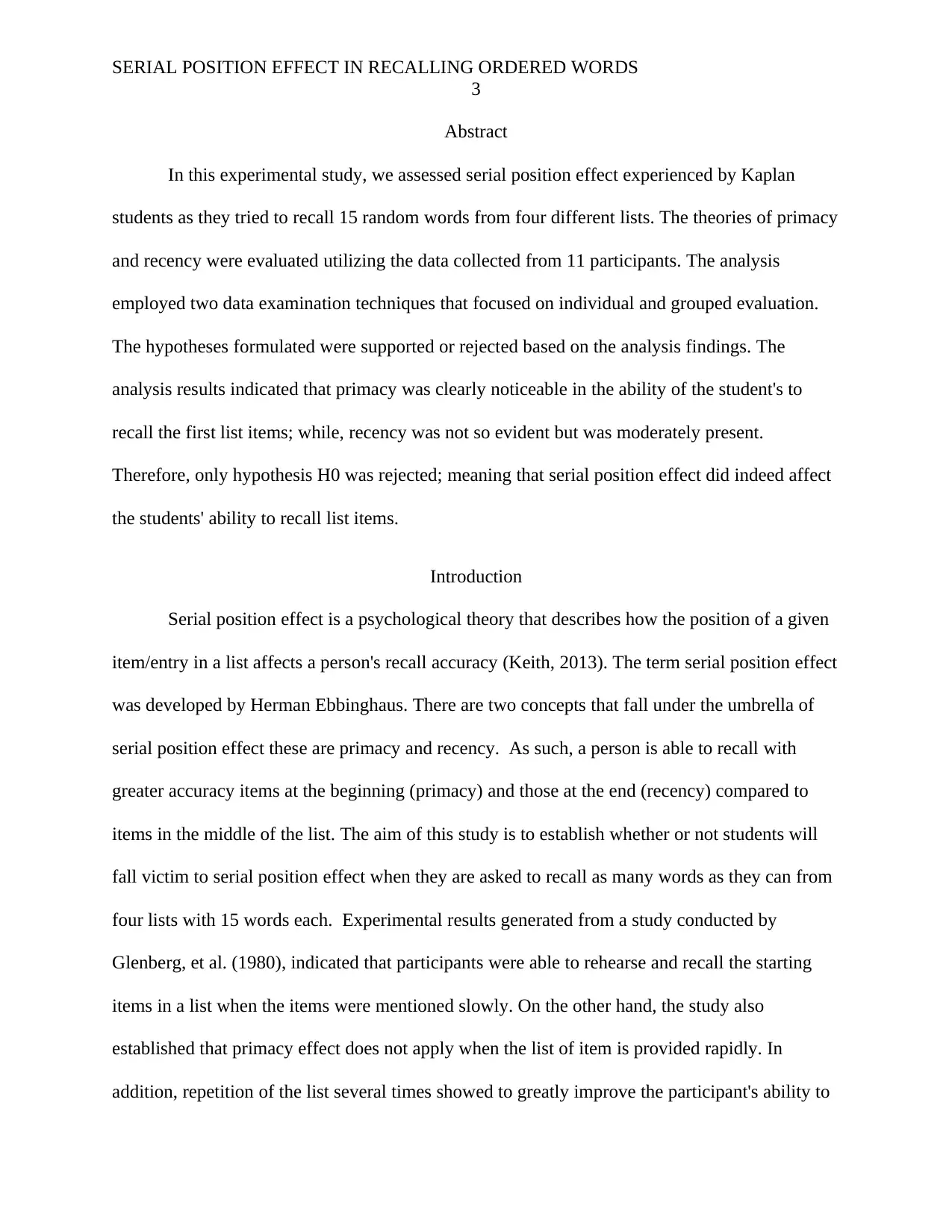
SERIAL POSITION EFFECT IN RECALLING ORDERED WORDS
3
Abstract
In this experimental study, we assessed serial position effect experienced by Kaplan
students as they tried to recall 15 random words from four different lists. The theories of primacy
and recency were evaluated utilizing the data collected from 11 participants. The analysis
employed two data examination techniques that focused on individual and grouped evaluation.
The hypotheses formulated were supported or rejected based on the analysis findings. The
analysis results indicated that primacy was clearly noticeable in the ability of the student's to
recall the first list items; while, recency was not so evident but was moderately present.
Therefore, only hypothesis H0 was rejected; meaning that serial position effect did indeed affect
the students' ability to recall list items.
Introduction
Serial position effect is a psychological theory that describes how the position of a given
item/entry in a list affects a person's recall accuracy (Keith, 2013). The term serial position effect
was developed by Herman Ebbinghaus. There are two concepts that fall under the umbrella of
serial position effect these are primacy and recency. As such, a person is able to recall with
greater accuracy items at the beginning (primacy) and those at the end (recency) compared to
items in the middle of the list. The aim of this study is to establish whether or not students will
fall victim to serial position effect when they are asked to recall as many words as they can from
four lists with 15 words each. Experimental results generated from a study conducted by
Glenberg, et al. (1980), indicated that participants were able to rehearse and recall the starting
items in a list when the items were mentioned slowly. On the other hand, the study also
established that primacy effect does not apply when the list of item is provided rapidly. In
addition, repetition of the list several times showed to greatly improve the participant's ability to
3
Abstract
In this experimental study, we assessed serial position effect experienced by Kaplan
students as they tried to recall 15 random words from four different lists. The theories of primacy
and recency were evaluated utilizing the data collected from 11 participants. The analysis
employed two data examination techniques that focused on individual and grouped evaluation.
The hypotheses formulated were supported or rejected based on the analysis findings. The
analysis results indicated that primacy was clearly noticeable in the ability of the student's to
recall the first list items; while, recency was not so evident but was moderately present.
Therefore, only hypothesis H0 was rejected; meaning that serial position effect did indeed affect
the students' ability to recall list items.
Introduction
Serial position effect is a psychological theory that describes how the position of a given
item/entry in a list affects a person's recall accuracy (Keith, 2013). The term serial position effect
was developed by Herman Ebbinghaus. There are two concepts that fall under the umbrella of
serial position effect these are primacy and recency. As such, a person is able to recall with
greater accuracy items at the beginning (primacy) and those at the end (recency) compared to
items in the middle of the list. The aim of this study is to establish whether or not students will
fall victim to serial position effect when they are asked to recall as many words as they can from
four lists with 15 words each. Experimental results generated from a study conducted by
Glenberg, et al. (1980), indicated that participants were able to rehearse and recall the starting
items in a list when the items were mentioned slowly. On the other hand, the study also
established that primacy effect does not apply when the list of item is provided rapidly. In
addition, repetition of the list several times showed to greatly improve the participant's ability to
⊘ This is a preview!⊘
Do you want full access?
Subscribe today to unlock all pages.

Trusted by 1+ million students worldwide
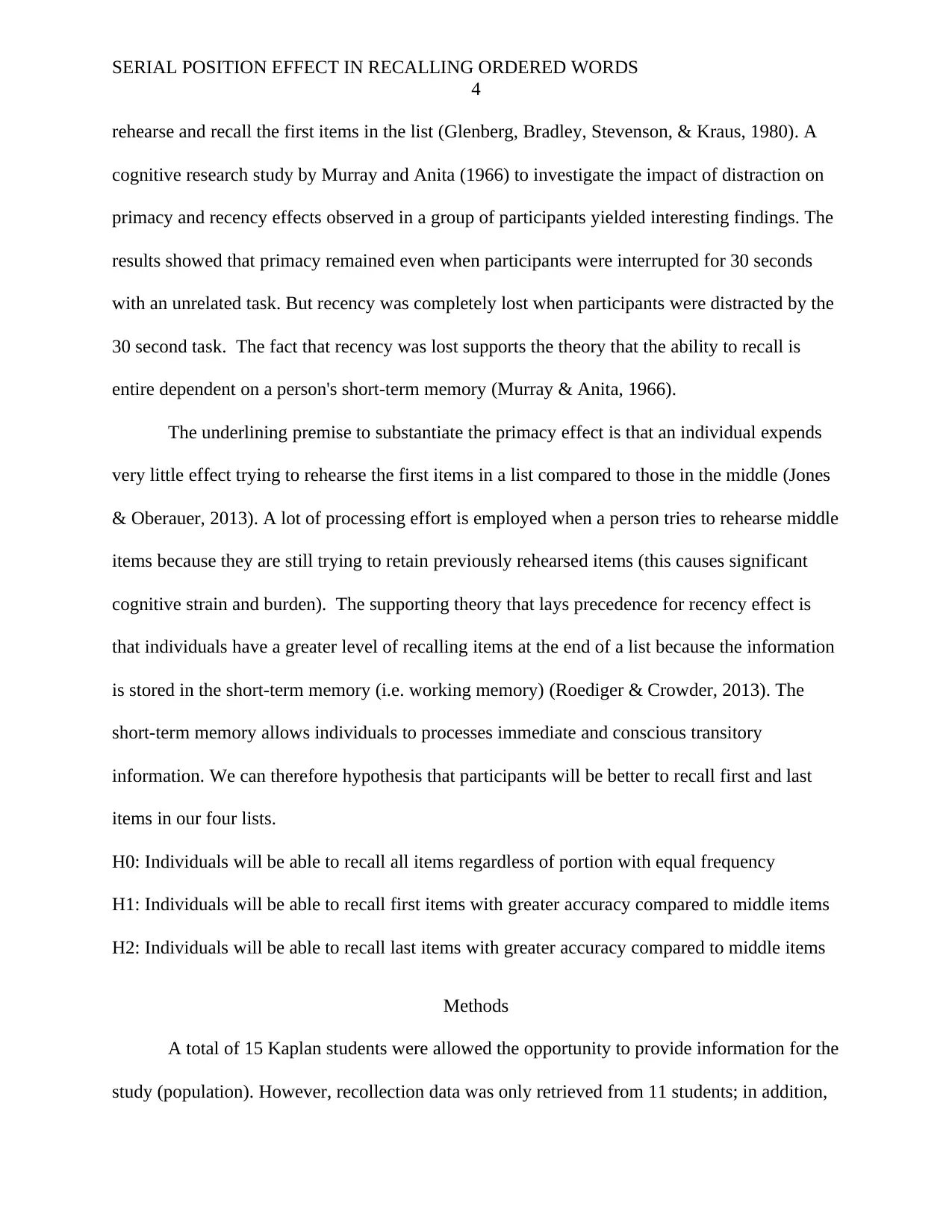
SERIAL POSITION EFFECT IN RECALLING ORDERED WORDS
4
rehearse and recall the first items in the list (Glenberg, Bradley, Stevenson, & Kraus, 1980). A
cognitive research study by Murray and Anita (1966) to investigate the impact of distraction on
primacy and recency effects observed in a group of participants yielded interesting findings. The
results showed that primacy remained even when participants were interrupted for 30 seconds
with an unrelated task. But recency was completely lost when participants were distracted by the
30 second task. The fact that recency was lost supports the theory that the ability to recall is
entire dependent on a person's short-term memory (Murray & Anita, 1966).
The underlining premise to substantiate the primacy effect is that an individual expends
very little effect trying to rehearse the first items in a list compared to those in the middle (Jones
& Oberauer, 2013). A lot of processing effort is employed when a person tries to rehearse middle
items because they are still trying to retain previously rehearsed items (this causes significant
cognitive strain and burden). The supporting theory that lays precedence for recency effect is
that individuals have a greater level of recalling items at the end of a list because the information
is stored in the short-term memory (i.e. working memory) (Roediger & Crowder, 2013). The
short-term memory allows individuals to processes immediate and conscious transitory
information. We can therefore hypothesis that participants will be better to recall first and last
items in our four lists.
H0: Individuals will be able to recall all items regardless of portion with equal frequency
H1: Individuals will be able to recall first items with greater accuracy compared to middle items
H2: Individuals will be able to recall last items with greater accuracy compared to middle items
Methods
A total of 15 Kaplan students were allowed the opportunity to provide information for the
study (population). However, recollection data was only retrieved from 11 students; in addition,
4
rehearse and recall the first items in the list (Glenberg, Bradley, Stevenson, & Kraus, 1980). A
cognitive research study by Murray and Anita (1966) to investigate the impact of distraction on
primacy and recency effects observed in a group of participants yielded interesting findings. The
results showed that primacy remained even when participants were interrupted for 30 seconds
with an unrelated task. But recency was completely lost when participants were distracted by the
30 second task. The fact that recency was lost supports the theory that the ability to recall is
entire dependent on a person's short-term memory (Murray & Anita, 1966).
The underlining premise to substantiate the primacy effect is that an individual expends
very little effect trying to rehearse the first items in a list compared to those in the middle (Jones
& Oberauer, 2013). A lot of processing effort is employed when a person tries to rehearse middle
items because they are still trying to retain previously rehearsed items (this causes significant
cognitive strain and burden). The supporting theory that lays precedence for recency effect is
that individuals have a greater level of recalling items at the end of a list because the information
is stored in the short-term memory (i.e. working memory) (Roediger & Crowder, 2013). The
short-term memory allows individuals to processes immediate and conscious transitory
information. We can therefore hypothesis that participants will be better to recall first and last
items in our four lists.
H0: Individuals will be able to recall all items regardless of portion with equal frequency
H1: Individuals will be able to recall first items with greater accuracy compared to middle items
H2: Individuals will be able to recall last items with greater accuracy compared to middle items
Methods
A total of 15 Kaplan students were allowed the opportunity to provide information for the
study (population). However, recollection data was only retrieved from 11 students; in addition,
Paraphrase This Document
Need a fresh take? Get an instant paraphrase of this document with our AI Paraphraser
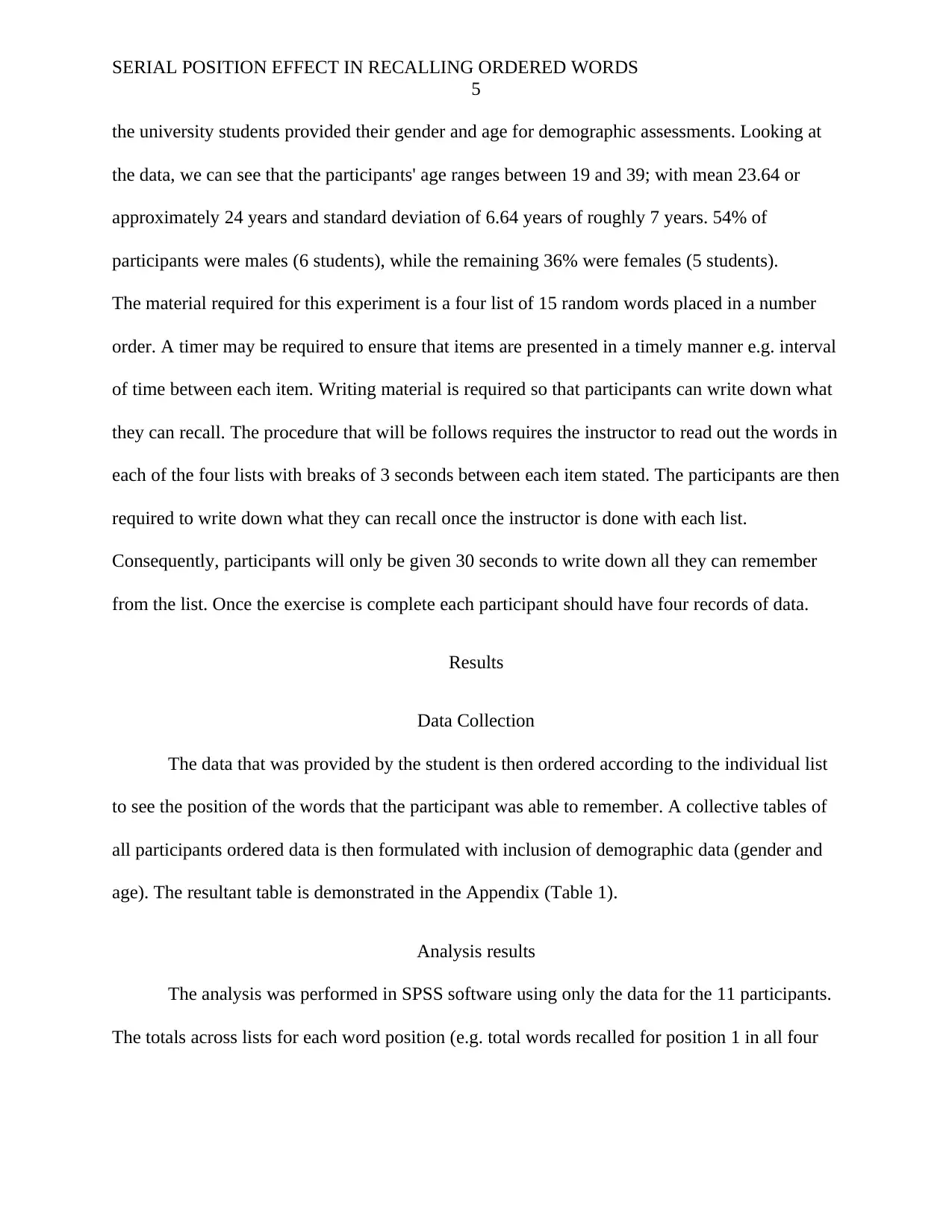
SERIAL POSITION EFFECT IN RECALLING ORDERED WORDS
5
the university students provided their gender and age for demographic assessments. Looking at
the data, we can see that the participants' age ranges between 19 and 39; with mean 23.64 or
approximately 24 years and standard deviation of 6.64 years of roughly 7 years. 54% of
participants were males (6 students), while the remaining 36% were females (5 students).
The material required for this experiment is a four list of 15 random words placed in a number
order. A timer may be required to ensure that items are presented in a timely manner e.g. interval
of time between each item. Writing material is required so that participants can write down what
they can recall. The procedure that will be follows requires the instructor to read out the words in
each of the four lists with breaks of 3 seconds between each item stated. The participants are then
required to write down what they can recall once the instructor is done with each list.
Consequently, participants will only be given 30 seconds to write down all they can remember
from the list. Once the exercise is complete each participant should have four records of data.
Results
Data Collection
The data that was provided by the student is then ordered according to the individual list
to see the position of the words that the participant was able to remember. A collective tables of
all participants ordered data is then formulated with inclusion of demographic data (gender and
age). The resultant table is demonstrated in the Appendix (Table 1).
Analysis results
The analysis was performed in SPSS software using only the data for the 11 participants.
The totals across lists for each word position (e.g. total words recalled for position 1 in all four
5
the university students provided their gender and age for demographic assessments. Looking at
the data, we can see that the participants' age ranges between 19 and 39; with mean 23.64 or
approximately 24 years and standard deviation of 6.64 years of roughly 7 years. 54% of
participants were males (6 students), while the remaining 36% were females (5 students).
The material required for this experiment is a four list of 15 random words placed in a number
order. A timer may be required to ensure that items are presented in a timely manner e.g. interval
of time between each item. Writing material is required so that participants can write down what
they can recall. The procedure that will be follows requires the instructor to read out the words in
each of the four lists with breaks of 3 seconds between each item stated. The participants are then
required to write down what they can recall once the instructor is done with each list.
Consequently, participants will only be given 30 seconds to write down all they can remember
from the list. Once the exercise is complete each participant should have four records of data.
Results
Data Collection
The data that was provided by the student is then ordered according to the individual list
to see the position of the words that the participant was able to remember. A collective tables of
all participants ordered data is then formulated with inclusion of demographic data (gender and
age). The resultant table is demonstrated in the Appendix (Table 1).
Analysis results
The analysis was performed in SPSS software using only the data for the 11 participants.
The totals across lists for each word position (e.g. total words recalled for position 1 in all four
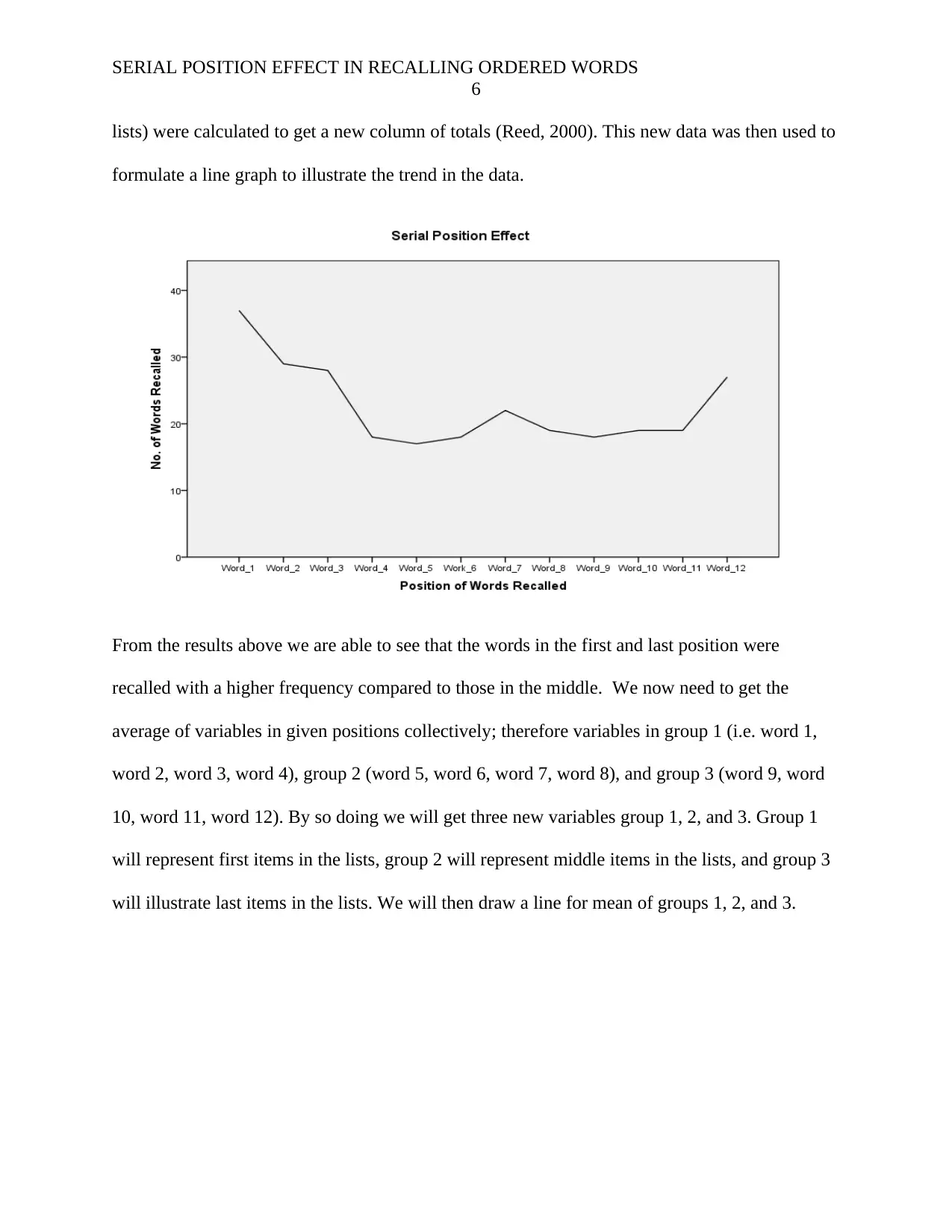
SERIAL POSITION EFFECT IN RECALLING ORDERED WORDS
6
lists) were calculated to get a new column of totals (Reed, 2000). This new data was then used to
formulate a line graph to illustrate the trend in the data.
From the results above we are able to see that the words in the first and last position were
recalled with a higher frequency compared to those in the middle. We now need to get the
average of variables in given positions collectively; therefore variables in group 1 (i.e. word 1,
word 2, word 3, word 4), group 2 (word 5, word 6, word 7, word 8), and group 3 (word 9, word
10, word 11, word 12). By so doing we will get three new variables group 1, 2, and 3. Group 1
will represent first items in the lists, group 2 will represent middle items in the lists, and group 3
will illustrate last items in the lists. We will then draw a line for mean of groups 1, 2, and 3.
6
lists) were calculated to get a new column of totals (Reed, 2000). This new data was then used to
formulate a line graph to illustrate the trend in the data.
From the results above we are able to see that the words in the first and last position were
recalled with a higher frequency compared to those in the middle. We now need to get the
average of variables in given positions collectively; therefore variables in group 1 (i.e. word 1,
word 2, word 3, word 4), group 2 (word 5, word 6, word 7, word 8), and group 3 (word 9, word
10, word 11, word 12). By so doing we will get three new variables group 1, 2, and 3. Group 1
will represent first items in the lists, group 2 will represent middle items in the lists, and group 3
will illustrate last items in the lists. We will then draw a line for mean of groups 1, 2, and 3.
⊘ This is a preview!⊘
Do you want full access?
Subscribe today to unlock all pages.

Trusted by 1+ million students worldwide

SERIAL POSITION EFFECT IN RECALLING ORDERED WORDS
7
From the graph above we are able to see that words in group 1 were recalled with a greater
frequency compare to those in group 2 and 3. Also group 3 items were recalled with a greater
frequency compared to group 2. The mean values of the three groups can be used to assess our
hypotheses. Where Group 1 will be used to substantiate primacy effect, Group 3 will be used to
validate recency effect and Group 2 will represent the control (i.e. middle values). We will
perform a one-way ANOVA on the three groups to test whether the means are the same for the
three groups.
7
From the graph above we are able to see that words in group 1 were recalled with a greater
frequency compare to those in group 2 and 3. Also group 3 items were recalled with a greater
frequency compared to group 2. The mean values of the three groups can be used to assess our
hypotheses. Where Group 1 will be used to substantiate primacy effect, Group 3 will be used to
validate recency effect and Group 2 will represent the control (i.e. middle values). We will
perform a one-way ANOVA on the three groups to test whether the means are the same for the
three groups.
Paraphrase This Document
Need a fresh take? Get an instant paraphrase of this document with our AI Paraphraser
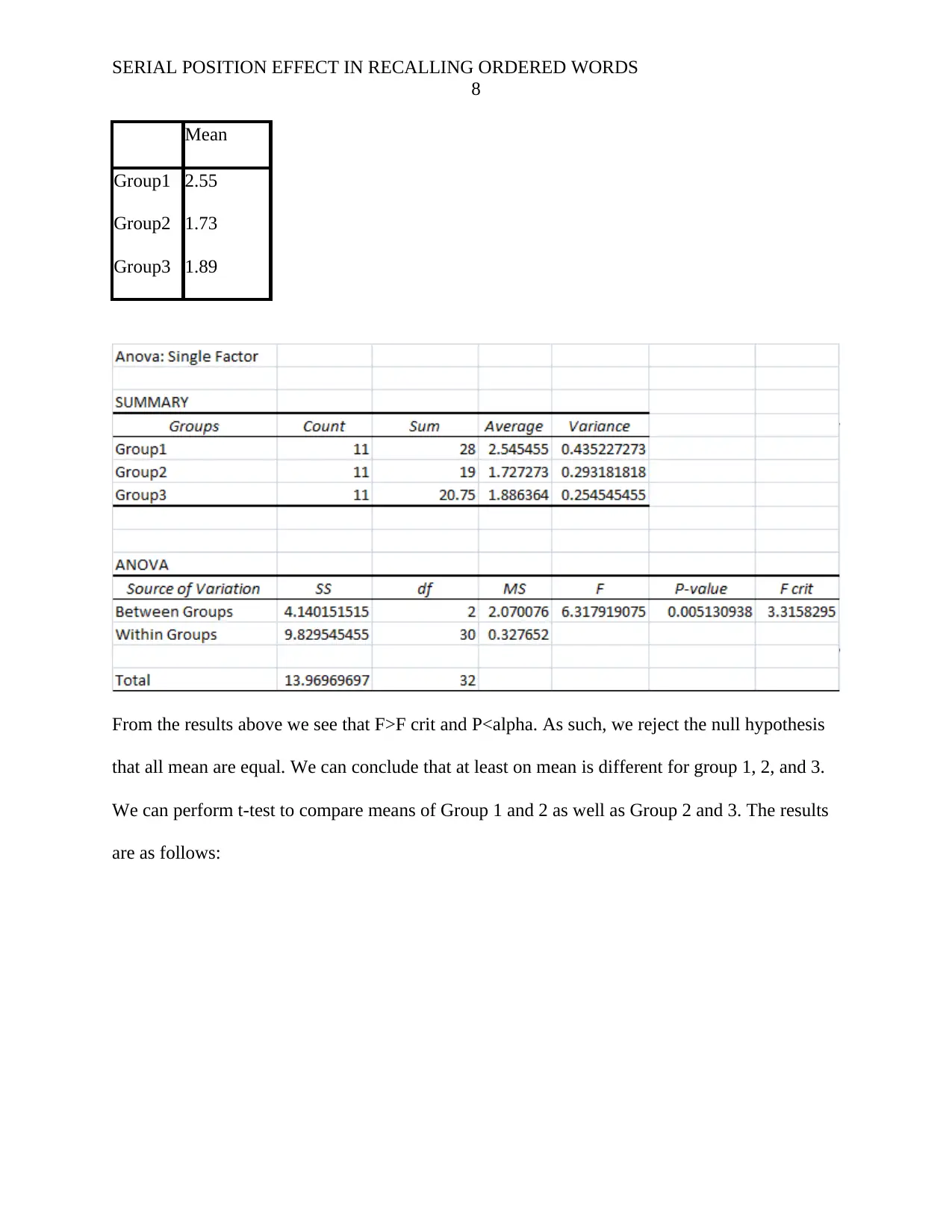
SERIAL POSITION EFFECT IN RECALLING ORDERED WORDS
8
Mean
Group1 2.55
Group2 1.73
Group3 1.89
From the results above we see that F>F crit and P<alpha. As such, we reject the null hypothesis
that all mean are equal. We can conclude that at least on mean is different for group 1, 2, and 3.
We can perform t-test to compare means of Group 1 and 2 as well as Group 2 and 3. The results
are as follows:
8
Mean
Group1 2.55
Group2 1.73
Group3 1.89
From the results above we see that F>F crit and P<alpha. As such, we reject the null hypothesis
that all mean are equal. We can conclude that at least on mean is different for group 1, 2, and 3.
We can perform t-test to compare means of Group 1 and 2 as well as Group 2 and 3. The results
are as follows:
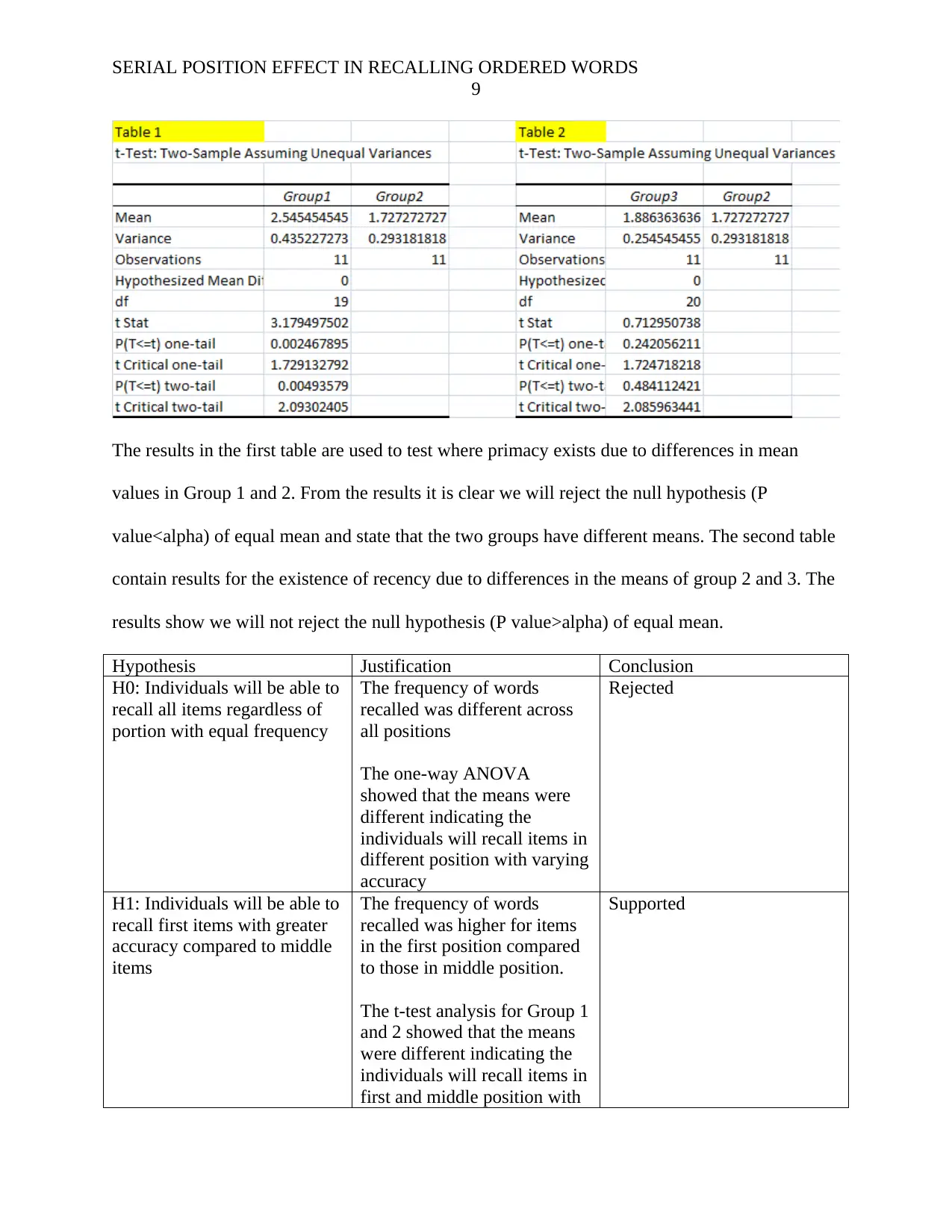
SERIAL POSITION EFFECT IN RECALLING ORDERED WORDS
9
The results in the first table are used to test where primacy exists due to differences in mean
values in Group 1 and 2. From the results it is clear we will reject the null hypothesis (P
value<alpha) of equal mean and state that the two groups have different means. The second table
contain results for the existence of recency due to differences in the means of group 2 and 3. The
results show we will not reject the null hypothesis (P value>alpha) of equal mean.
Hypothesis Justification Conclusion
H0: Individuals will be able to
recall all items regardless of
portion with equal frequency
The frequency of words
recalled was different across
all positions
The one-way ANOVA
showed that the means were
different indicating the
individuals will recall items in
different position with varying
accuracy
Rejected
H1: Individuals will be able to
recall first items with greater
accuracy compared to middle
items
The frequency of words
recalled was higher for items
in the first position compared
to those in middle position.
The t-test analysis for Group 1
and 2 showed that the means
were different indicating the
individuals will recall items in
first and middle position with
Supported
9
The results in the first table are used to test where primacy exists due to differences in mean
values in Group 1 and 2. From the results it is clear we will reject the null hypothesis (P
value<alpha) of equal mean and state that the two groups have different means. The second table
contain results for the existence of recency due to differences in the means of group 2 and 3. The
results show we will not reject the null hypothesis (P value>alpha) of equal mean.
Hypothesis Justification Conclusion
H0: Individuals will be able to
recall all items regardless of
portion with equal frequency
The frequency of words
recalled was different across
all positions
The one-way ANOVA
showed that the means were
different indicating the
individuals will recall items in
different position with varying
accuracy
Rejected
H1: Individuals will be able to
recall first items with greater
accuracy compared to middle
items
The frequency of words
recalled was higher for items
in the first position compared
to those in middle position.
The t-test analysis for Group 1
and 2 showed that the means
were different indicating the
individuals will recall items in
first and middle position with
Supported
⊘ This is a preview!⊘
Do you want full access?
Subscribe today to unlock all pages.

Trusted by 1+ million students worldwide
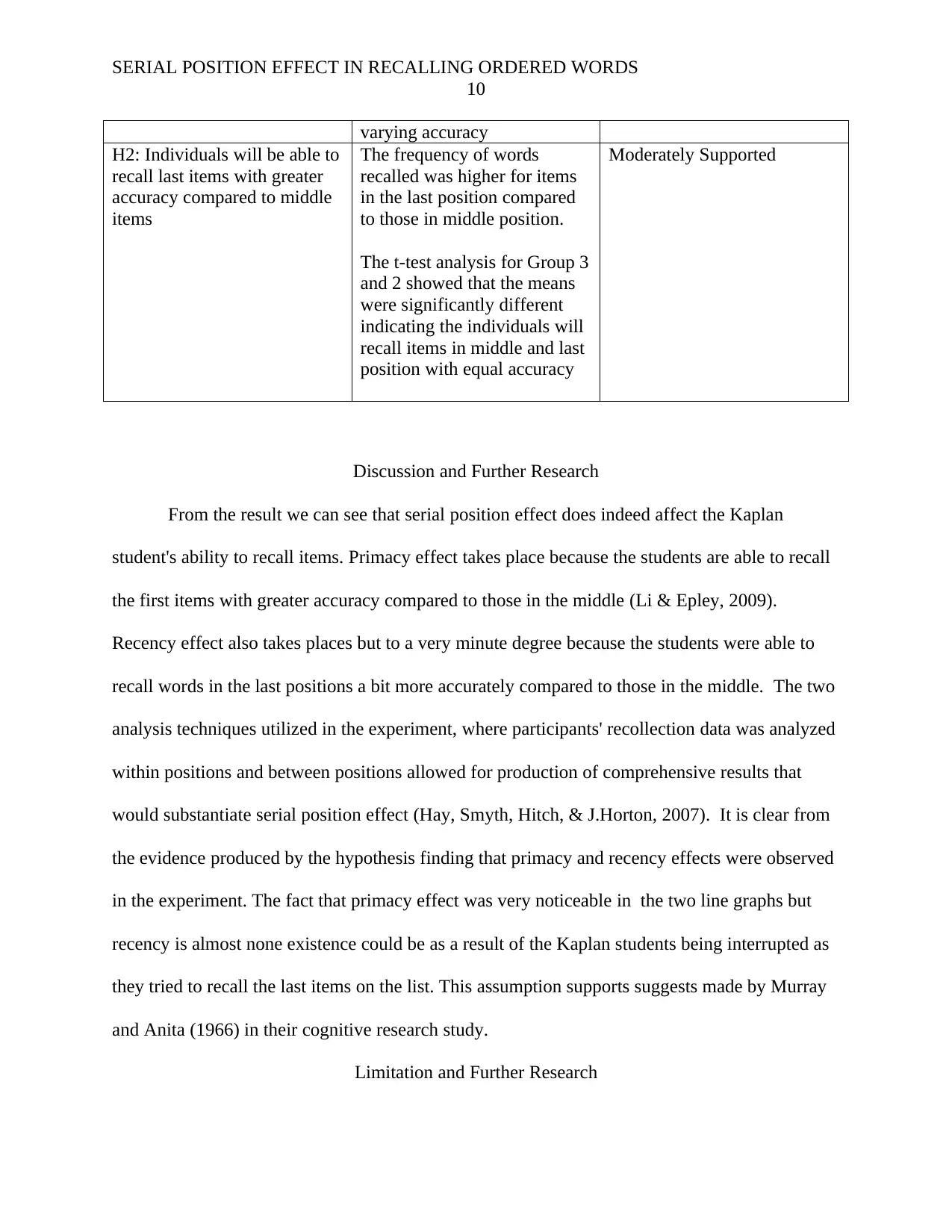
SERIAL POSITION EFFECT IN RECALLING ORDERED WORDS
10
varying accuracy
H2: Individuals will be able to
recall last items with greater
accuracy compared to middle
items
The frequency of words
recalled was higher for items
in the last position compared
to those in middle position.
The t-test analysis for Group 3
and 2 showed that the means
were significantly different
indicating the individuals will
recall items in middle and last
position with equal accuracy
Moderately Supported
Discussion and Further Research
From the result we can see that serial position effect does indeed affect the Kaplan
student's ability to recall items. Primacy effect takes place because the students are able to recall
the first items with greater accuracy compared to those in the middle (Li & Epley, 2009).
Recency effect also takes places but to a very minute degree because the students were able to
recall words in the last positions a bit more accurately compared to those in the middle. The two
analysis techniques utilized in the experiment, where participants' recollection data was analyzed
within positions and between positions allowed for production of comprehensive results that
would substantiate serial position effect (Hay, Smyth, Hitch, & J.Horton, 2007). It is clear from
the evidence produced by the hypothesis finding that primacy and recency effects were observed
in the experiment. The fact that primacy effect was very noticeable in the two line graphs but
recency is almost none existence could be as a result of the Kaplan students being interrupted as
they tried to recall the last items on the list. This assumption supports suggests made by Murray
and Anita (1966) in their cognitive research study.
Limitation and Further Research
10
varying accuracy
H2: Individuals will be able to
recall last items with greater
accuracy compared to middle
items
The frequency of words
recalled was higher for items
in the last position compared
to those in middle position.
The t-test analysis for Group 3
and 2 showed that the means
were significantly different
indicating the individuals will
recall items in middle and last
position with equal accuracy
Moderately Supported
Discussion and Further Research
From the result we can see that serial position effect does indeed affect the Kaplan
student's ability to recall items. Primacy effect takes place because the students are able to recall
the first items with greater accuracy compared to those in the middle (Li & Epley, 2009).
Recency effect also takes places but to a very minute degree because the students were able to
recall words in the last positions a bit more accurately compared to those in the middle. The two
analysis techniques utilized in the experiment, where participants' recollection data was analyzed
within positions and between positions allowed for production of comprehensive results that
would substantiate serial position effect (Hay, Smyth, Hitch, & J.Horton, 2007). It is clear from
the evidence produced by the hypothesis finding that primacy and recency effects were observed
in the experiment. The fact that primacy effect was very noticeable in the two line graphs but
recency is almost none existence could be as a result of the Kaplan students being interrupted as
they tried to recall the last items on the list. This assumption supports suggests made by Murray
and Anita (1966) in their cognitive research study.
Limitation and Further Research
Paraphrase This Document
Need a fresh take? Get an instant paraphrase of this document with our AI Paraphraser

SERIAL POSITION EFFECT IN RECALLING ORDERED WORDS
11
The major limitation associated with this study is research biasness. The research already
has personal presumption of how the results will be thereby creating biasness related to how the
results are generated and interpreted. The second limitation is a small sample size; very few
participants were employed in the study (11 Kaplan students). In order to increase result
reliability more student should have been included in the study. The third limitation is lack of
proper timing of duration between responses and presentation of words in different lists. If the
duration was irregular this could affect the way the student recall words in different lists. For
instance, if the students are asked to recall after 30 seconds then they will record different results
compared to when they are asked to recall immediately after the list is read.
Further research should be conducted to assess the effect of distraction on the primacy
and recency associated with responses given by Kaplan Students. A study can be developed that
allows the participants to be interrupted for 30 seconds after they are presented with all the words
in a particular list. In addition, further research can be conducted to evaluate the impact of few
words in multiple lists on primacy and recency. If the words in a list are varied between 5 and 20
words and the number of lists is held constant at 10; i hypothesize that primacy and recency will
be lost when few words are employed because it will be easy for the students to recall with equal
accuracy. As such, there will b very little distinction between the first, middle, and last word
when the list items are considerably few. When the words are considerably many (20 words in a
list) I hypothesize that primacy will be lost but recency will remain because the student will be
compelled to remember only the last words in the list. As such, rehearsal will fail when the items
are considerable many; since, the student will be struggling to retain every new word presented.
11
The major limitation associated with this study is research biasness. The research already
has personal presumption of how the results will be thereby creating biasness related to how the
results are generated and interpreted. The second limitation is a small sample size; very few
participants were employed in the study (11 Kaplan students). In order to increase result
reliability more student should have been included in the study. The third limitation is lack of
proper timing of duration between responses and presentation of words in different lists. If the
duration was irregular this could affect the way the student recall words in different lists. For
instance, if the students are asked to recall after 30 seconds then they will record different results
compared to when they are asked to recall immediately after the list is read.
Further research should be conducted to assess the effect of distraction on the primacy
and recency associated with responses given by Kaplan Students. A study can be developed that
allows the participants to be interrupted for 30 seconds after they are presented with all the words
in a particular list. In addition, further research can be conducted to evaluate the impact of few
words in multiple lists on primacy and recency. If the words in a list are varied between 5 and 20
words and the number of lists is held constant at 10; i hypothesize that primacy and recency will
be lost when few words are employed because it will be easy for the students to recall with equal
accuracy. As such, there will b very little distinction between the first, middle, and last word
when the list items are considerably few. When the words are considerably many (20 words in a
list) I hypothesize that primacy will be lost but recency will remain because the student will be
compelled to remember only the last words in the list. As such, rehearsal will fail when the items
are considerable many; since, the student will be struggling to retain every new word presented.

SERIAL POSITION EFFECT IN RECALLING ORDERED WORDS
12
Conclusion
Serial position effect did take place with primacy being more notable than recency. As
such, the students were able to recall items in the first and last position with greater accuracy
compared to those items in the middle of the four lists. It is appropriate to note that the fact that
recency was almost void cold be as a result of rapid presentation of list items or interruption
during recollection process.
Reference
12
Conclusion
Serial position effect did take place with primacy being more notable than recency. As
such, the students were able to recall items in the first and last position with greater accuracy
compared to those items in the middle of the four lists. It is appropriate to note that the fact that
recency was almost void cold be as a result of rapid presentation of list items or interruption
during recollection process.
Reference
⊘ This is a preview!⊘
Do you want full access?
Subscribe today to unlock all pages.

Trusted by 1+ million students worldwide
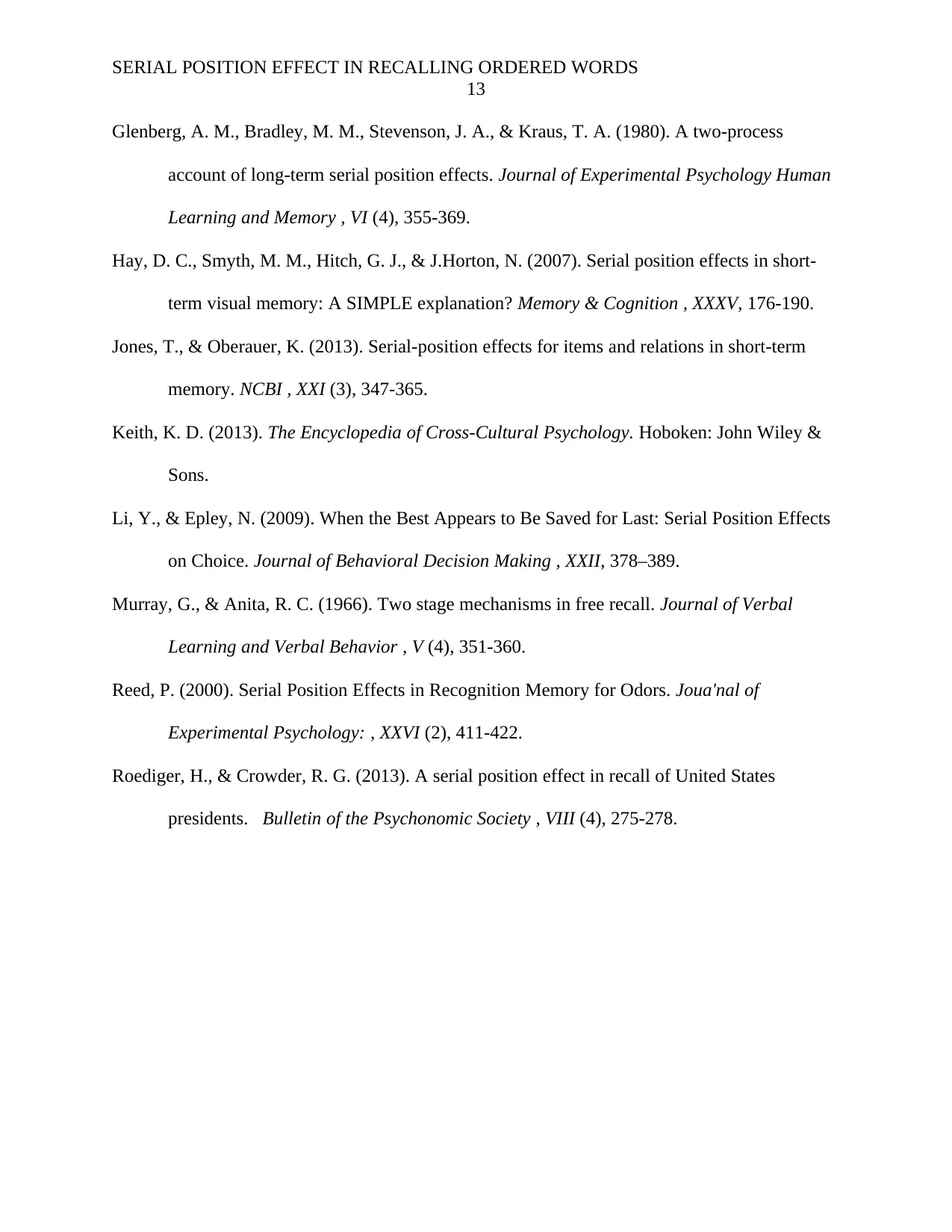
SERIAL POSITION EFFECT IN RECALLING ORDERED WORDS
13
Glenberg, A. M., Bradley, M. M., Stevenson, J. A., & Kraus, T. A. (1980). A two-process
account of long-term serial position effects. Journal of Experimental Psychology Human
Learning and Memory , VI (4), 355-369.
Hay, D. C., Smyth, M. M., Hitch, G. J., & J.Horton, N. (2007). Serial position effects in short-
term visual memory: A SIMPLE explanation? Memory & Cognition , XXXV, 176-190.
Jones, T., & Oberauer, K. (2013). Serial-position effects for items and relations in short-term
memory. NCBI , XXI (3), 347-365.
Keith, K. D. (2013). The Encyclopedia of Cross-Cultural Psychology. Hoboken: John Wiley &
Sons.
Li, Y., & Epley, N. (2009). When the Best Appears to Be Saved for Last: Serial Position Effects
on Choice. Journal of Behavioral Decision Making , XXII, 378–389.
Murray, G., & Anita, R. C. (1966). Two stage mechanisms in free recall. Journal of Verbal
Learning and Verbal Behavior , V (4), 351-360.
Reed, P. (2000). Serial Position Effects in Recognition Memory for Odors. Joua'nal of
Experimental Psychology: , XXVI (2), 411-422.
Roediger, H., & Crowder, R. G. (2013). A serial position effect in recall of United States
presidents. Bulletin of the Psychonomic Society , VIII (4), 275-278.
13
Glenberg, A. M., Bradley, M. M., Stevenson, J. A., & Kraus, T. A. (1980). A two-process
account of long-term serial position effects. Journal of Experimental Psychology Human
Learning and Memory , VI (4), 355-369.
Hay, D. C., Smyth, M. M., Hitch, G. J., & J.Horton, N. (2007). Serial position effects in short-
term visual memory: A SIMPLE explanation? Memory & Cognition , XXXV, 176-190.
Jones, T., & Oberauer, K. (2013). Serial-position effects for items and relations in short-term
memory. NCBI , XXI (3), 347-365.
Keith, K. D. (2013). The Encyclopedia of Cross-Cultural Psychology. Hoboken: John Wiley &
Sons.
Li, Y., & Epley, N. (2009). When the Best Appears to Be Saved for Last: Serial Position Effects
on Choice. Journal of Behavioral Decision Making , XXII, 378–389.
Murray, G., & Anita, R. C. (1966). Two stage mechanisms in free recall. Journal of Verbal
Learning and Verbal Behavior , V (4), 351-360.
Reed, P. (2000). Serial Position Effects in Recognition Memory for Odors. Joua'nal of
Experimental Psychology: , XXVI (2), 411-422.
Roediger, H., & Crowder, R. G. (2013). A serial position effect in recall of United States
presidents. Bulletin of the Psychonomic Society , VIII (4), 275-278.
Paraphrase This Document
Need a fresh take? Get an instant paraphrase of this document with our AI Paraphraser
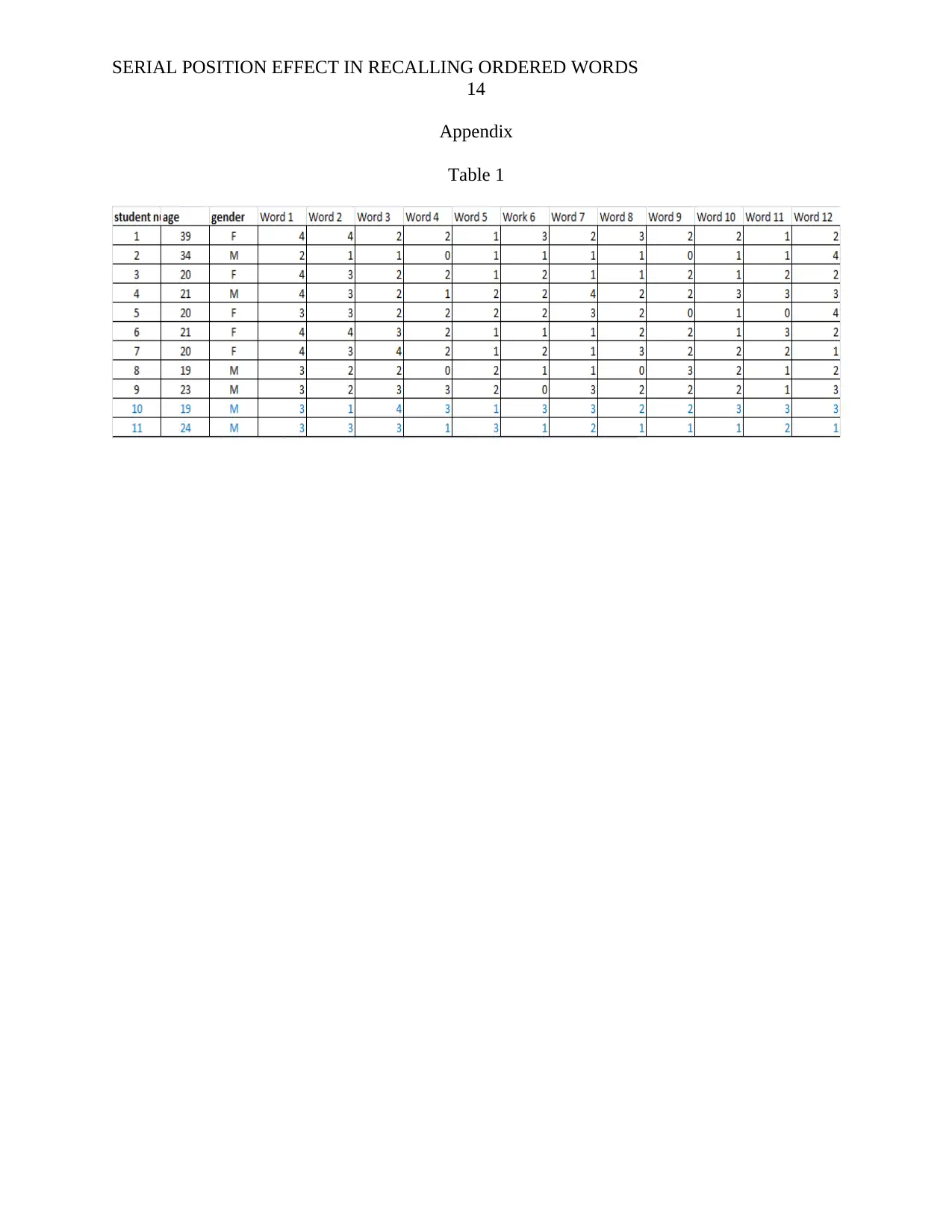
SERIAL POSITION EFFECT IN RECALLING ORDERED WORDS
14
Appendix
Table 1
14
Appendix
Table 1
1 out of 14
Related Documents
Your All-in-One AI-Powered Toolkit for Academic Success.
+13062052269
info@desklib.com
Available 24*7 on WhatsApp / Email
![[object Object]](/_next/static/media/star-bottom.7253800d.svg)
Unlock your academic potential
© 2024 | Zucol Services PVT LTD | All rights reserved.





